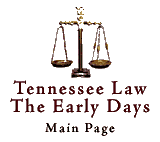
Click Here
TNGenWeb Project
Compiled by Fred Smoot
Banns, Marriage Bonds and Licenses, and Bastardy Bonds
Under ConstructionThe subject on the procedure of early Tennessee marriage, deserves a close look. In time, we hope to add the actually Tennessee laws regulating marriage. Introduction
The Tennessee laws of marriage would certainly have their roots in North Carolina colonial laws and the laws of other colonies, especially Virginia. Here we will look at some marriage procedures of Old Virginia and Tennessee.
F. Smoot
In order to be married outside of the civil authorities, a couple could publish “banns,” or intent to be married, at there local church or meeting house for three consecutive weeks, or meetings. If there were no objection to the marriage, the clergyman would marry the couple. This “marriage by banns” required no reporting to civil authorities, therefore it was recorded only in the church records and perhaps the family Bible. Unfortunately, many church records have been lost, leaving many a genealogist searching for the old elusive family Bible. Banns
A Very Colonial Marriage Procedure
The main objection to the marriage that could be raised was the question of an earlier marriage by either the man or the woman. Bigamy existed then, just as it does today.
A more legal definition of “Banns of matrimony” from Black’s Law Dictionary, Sixth Edition:“Public notice or proclamation of a matrimonial contract, and the intended celebration of the marriage of the parties in pursuance of such contract. Such announcement is required by certain religions to be made in a church or chapel, during service, on three consecutive Sundays before the marriage is celebrated. The object of is to afford an opportunity for any person to interpose an objection if he knows any impediment or other just cause why the marriage should not take place.”“In 1660-61 the [Virginia] law requiring a bond was first enacted. Because of a scarcity of ministers, the colony required that all persons wishing to be married by license must go to the county court clerk and give bond with sufficient security (usually $150 by the 19th century) that there was no lawful cause to prevent the marriage. The license was then prepared by the clerk and presented to the minister who would perform the ceremony.” From the introduction to the published Frederick Co., VA Marriage Bonds, by John Vogt & T. William Kethley, Jr., Iberian Publishing Company. Marriage Bonds and Licenses
The bondsman or surety was to be “able and knowne.” Often, this person was a brother or uncle to the bride, not necessarily a parent. The rich and established uncle was an excellent candidate for bondsman. The bondsman could be related to the groom, but from what we have seen, that situation would occur less often.
In Tennessee, three documents were created at the time of a marriage.
- The first was the marriage bond.
- The second was the license, wherein the court authorized the marriage, and the official signed the back to show that it had been performed.
- The ledger where the clerk copied some information from these two sources is known as the official marriage record, and is often the only surviving part of the record.
Charles A. Sherrill, Tenn. State Library & Archives; has furnished the following information on this subject according to his understanding of the material he has read.
- The groom had to assure the State that he was able to be legally married (was not already married to someone else, under age, or ineligible because of close blood relationship, etc.)
- This assurance was given in the form of a bond for a certain amount of money. The friend or relative signed as the groom's security on the bond, commonly known as becoming a bondsman.
- If indeed the groom had been sued for violating the marriage contract, the bondsman would have had to pay any legal damages if the groom defaulted.
- No money actually changed hands at the time the bond was issued.
- This bonding procedure was used across Tennessee and in other southern states in the 19th century.
“I am not certain whether a woman could sue for breach of contract under this bond, in a case where a man failed to actually go through with the marriage. I have seen one or two cases of that type, but do not know whether they were successful. However, this bond did provide legal protection for a woman who married a man and then found he already had a wife.”
This bond was required from father of illegitimate children. This bond was usually made with County Court where the mother resided. The intent was to protect the county from being forced to support the child. Occasionally, these records still survive. Bastardy Bonds
John Haywood’s manual for Tennessee Justices of the Peace (1810, reissued 1816) lists bastardy as an un-indictable offence which can be tried before any two justices. If found guilty the father is to be brought before the full court to provide bond and security. This would be the County Court comprised of all the justices, not the Superior Court. The bond is technically a “bastardy” bond, not a “bastard” bond. (Charles A. Sherrill, Tenn. State Library & Archives.)
